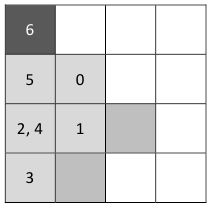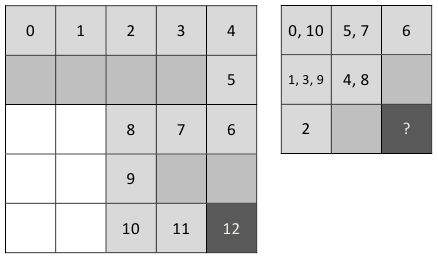
| E: Face the Maze |
This problem consists of traversing deterministically a discrete surface represented by a matrix of n x n cells (n > 2), starting at a source cell, ending at a target cell, and considering the existence of static obstacles in the form of unavailable cells. The key idea is that from the source cell, the position of the target cell is unknown; thus, a path starting from source cell must be created on the run until target cell is found.
Only vertical and horizontal movements are allowed. The choice of the next cell visited is given by the following list of priorities.
If either source cell or target cell is trapped in a dead end, eventually the path will return to the start point. In such a case, the travel must end.
For a better understanding of this problem, consider the first test case from Sample Input, where source cell is at (2, 2), target is at (1, 1), and cells (3, 3) and (2, 4) are unavailable. As can be seen in the following figure, the path from source to target considering the priorities enlisted above is as follows: 1) go down, 2) go to the left, 3) go down, 4) go back, 5) go up, 6) go to the target.

The first line contains an integer N > 0 denoting the number of test cases.
The next N lines contain a space-separated list
starting with an integer n > 1 denoting the number of rows (or columns) in the surface, and followed by m![]() 2 pairs of integers (i, j),
such that:
2 pairs of integers (i, j),
such that:
The output consists of N lines containing the path produced at each test case. The path is specified by means of a space-separated list of m pairs of integers (i, j), such that:
Note: Images from test cases 2 and 3

3 4 (2,2) (1,1) (3,3) (2,4) 5 (1,1) (5,5) (1,2) (2,2) (3,2) (4,2) (4,4) (5,4) 3 (1,1) (3,3) (3,2) (2,3)
(2,2) (2,3) (1,3) (1,4) (1,3) (1,2) (1,1) (1,1) (2,1) (3,1) (4,1) (5,1) (5,2) (5,3) (4,3) (3,3) (3,4) (3,5) (4,5) (5,5) (1,1) (1,2) (1,3) (1,2) (2,2) (2,1) (3,1) (2,1) (2,2) (1,2) (1,1)